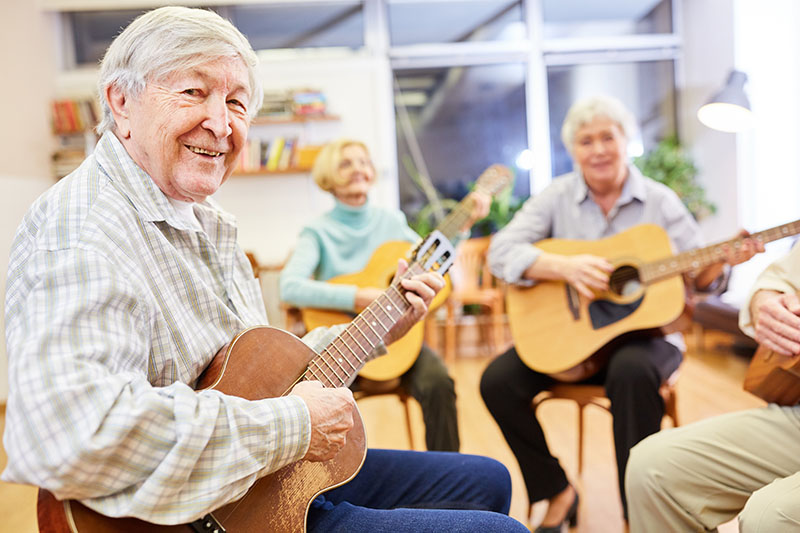
Could Musical Medicine Influence Healthy Aging?
Many of us have favorite songs that can help us relax after a hectic day or get us moving on the dance floor. Music can also be a powerful gateway to memory; for example, a song from our past may bring back memories that trigger strong emotions.
But what is happening in our brains when we hear a song that is meaningful to us? Could music make older adults not only feel better but also improve their health? Much more research is needed before any definitive conclusions can be drawn, but there is growing scientific interest in music’s effects on the brain and body as we age.
How the brain is wired for music and memory
Psyche Loui, Ph.D., leads the Music, Imaging, and Neural Dynamics (MIND) Lab at Northeastern University in Boston. She also plays the violin in Boston’s Longwood Symphony Orchestra and in a variety of local pop and chamber music groups. In the laboratory, she seeks to understand how the parts of the brain that relate to musical perception and processing interact with brain regions controlling learning, memory, and emotions. Interested in music and science most of her life, she first became curious about how music might help people with dementia while volunteering at a nursing home as a high school student.
After little response from residents with advanced dementia to the Beethoven pieces she played on the piano, staff members encouraged her to try something a bit livelier from a book of traditional folk songs. “I just played some old familiar ditties and tunes, and then, amazingly, some of the residents knew all the words and started singing along in close harmony,” said Loui. “That just really struck me.”
Our brains are hard-wired to predict and anticipate familiar rhythms and melodies, Loui explained. It starts with the auditory cortex, the brain region that receives and processes sounds, including voices and music. “When we hear something that we enjoy, that engages not only the auditory cortex, but also the brain’s reward systems that are driven by the neurotransmitter dopamine, which motivates us to seek out and learn new information.”
Another key part of the brain’s dopamine-based reward system is the medial prefrontal cortex, which also processes memories about ourselves. “If I’m listening to music that I’ve enjoyed throughout my life, and that I find familiar, then the auditory system is active, but it’s also communicating and connecting with the medial prefrontal cortex,” said Loui.
Working with like-minded researchers in the Boston area at the Berklee College of Music and Harvard Medical School, Loui and colleagues developed an eight-week mindful music-based listening program for healthy older adults. Participants showed stronger increases in functional connectivity between the auditory system and the medial prefrontal cortex — areas that generally become less active with age — compared to control groups. Their team is now testing out this intervention in older adults with memory impairments, hoping that music can help revive learning and memory functions through this connectivity.
Loui’s latest project is the Multimodal Musical Stimulation for Healthy Neurocognitive Aging study, which is designing and testing a device that pairs music selected by participants with rhythmic, colored LED light patterns. Supported with NIA small business funding, the technology is based on mouse studies in which Alzheimer’s disease-related brain deposits of tau and beta-amyloid proteins were reduced through light and sound stimuli. Loui and colleagues are working on prototypes to test the light and sound intervention as a potential therapy for older adults and for people living with mild cognitive impairment or dementia.
Singing to build cognitive and social connections
Another interesting area of research is the exploration of whether music can strengthen connections not just between our neurons, but also between people, to enhance social networks and reduce isolation and loneliness among older adults.
Julene Johnson, Ph.D., blends her love of music and cognitive neuroscience as a professor at the University of California, San Francisco. Trained as a flutist, she is also the co-director of the Sound Health Network, which falls under the umbrella of Sound Health, a partnership that involves NIH, the National Endowment for the Arts, John F. Kennedy Center for the Performing Arts, and famed soprano singer Renée Fleming. The goal is to expand our understanding of how listening to or creating music might affect overall health and wellness.
Johnson has studied music and the mind for more than 25 years, including through her Fulbright fellowship in Finland to study whether community choir participation affected healthy aging. She also led the Community of Voices study, which tested the impact of participating in a community choir for six months on the health and well-being of ethnically diverse older adults.
The study involved 390 participants in 12 choirs, many of which are still active today in the San Francisco area. While the research did not show changes in cognitive outcomes, participants reported reduced feelings of loneliness and an increased interest in life. Participants noted higher self-esteem, an enhanced sense of finding a place in society, and stronger cultural identity. The singers also reported beneficial physical effects (including improved breath capacity) and psychosocial effects (such as higher assertiveness and confidence in one’s voice).
Johnson’s current study is testing whether a musical improvisation intervention can improve cognition and brain function in older adults with mild cognitive impairment. “In improvisation, you have to be creative and generate new ideas,” Johnson said. “If you’re too critical of how you’re playing, that interferes with your ability to improvise.” The idea is to learn to tune out or turn off the brain’s critical thinking to get into an in-the-moment “zone.”
Johnson is passionate about training future musical scientists to advance our knowledge about music as a potential therapy. “We don’t understand all of the cognitive, social, or psychological mechanisms by which music can impact health and well-being,” she said. “The next generation needs unique skills to do this very interdisciplinary type of work.”
Can music reduce patient delirium in the ICU?
Between 70% and 80% of intensive care unit (ICU) patients who receive respiratory support from mechanical ventilators experience delirium — a syndrome of sudden, acute confusion that can occur after major surgery or during a serious illness. In some patients, delirium can cause agitation, aggression, or hallucinations while others may be drowsy. Patients who experience delirium tend to have longer stays in the ICU, and more than 30% of patients who develop it experience long-term cognitive impairment. They are also more likely to be transferred to nursing homes or rehabilitation facilities after they leave the hospital.
The Decreasing Delirium Through Music in Critically Ill Older Adults study, led by Babar A. Khan, M.D., at the Indiana University School of Medicine, and Linda L. Chlan, Ph.D., R.N., at Mayo Clinic, is exploring whether listening to carefully sequenced music designed as a complex cognitive stimulus while in the ICU can lead to fewer patients experiencing delirium.
Khan and Chlan have been collaborating on ICU music listening intervention for about 10 years. Earlier in his career, Khan conducted trials to test antipsychotic drugs to prevent delirium. The study results were disappointing: The drugs weren’t very effective, and any benefit was often outweighed by serious side effects.
Chlan has been investigating music listening interventions over the past 25 years. Her previous work suggested that carefully selected, preferred music with a tempo of 60 to 80 beats per minute could decrease anxiety and reduce ventilated patients’ exposure to potent sedative or opioid medications. Another study she led found that ventilated patients who listened to preferred relaxing music whenever desired and for as long as they wanted were taken off a ventilator (to breathe independently) an average of 1.4 days earlier than control groups.
While Khan doesn’t play an instrument himself, his family inspired him to look deeper into music. He loved listening to his brother play guitar and organ when they were growing up, and today enjoys listening to his daughter play violin and piano. “One of my favorite things whenever my brother was playing was to just sit down and drop everything and just listen,” Khan said.
“You take a little bit of a break and somehow it restores the thought process, or just kind of recalibrates the cognition. So, I thought, if music has a calming effect outside the ICU, why wouldn’t it have a calming effect in the ICU?”
Khan’s and Chlan’s preliminary findings suggest that playing two 60-minute doses per day of slow and relaxing combinations of piano, rainfall sounds, and classical music help reduce the burden of delirium in adult ICU patients compared to a control group who received doses of listening to audiobooks. Khan, Chlan, and colleagues are now working to expand their research in this area.
Khan says he’s been pleasantly surprised by music’s impact. “Believe it or not, before I started doing research and before meeting Dr. Chlan, I never thought that music could be a potential therapy,” Khan said. Now, he sees a possible future where music could be instrumental in reducing delirium and easing anxiety and stress for families, nurses, and caregivers.
Soothing sleep with music in people living with dementia
People living with Alzheimer’s or a related dementia often experience sleep disturbances, such as insomnia or waking up during the night. These sleep problems can also disrupt their caregivers’ sleep, contributing to poorer physical and mental health in people who may already feel overwhelmed. For those living with dementia, sleep disruption has been associated with more time in health care facilities, poorer cognitive function, and faster disease progression.
Darina Petrovsky, Ph.D., R.N., of Rutgers University, is testing whether music can be an effective intervention to help ease these problems. A serious musician since age 7, Petrovsky studied piano performance as an undergraduate and later completed master’s and doctoral training in nursing.
As part of her study, Petrovsky and her team are developing and testing a mobile app called Calming Music Personalized for Sleep Enhancement in PeRsons living with Dementia (CoMPoSER). CoMPoSER helps caregivers tailor music to play before bedtime with the goal of a more restful night for all. CoMPoSER’s recipe for good sleeping music includes enjoyable songs from a person’s adolescence or early adulthood with a tempo of between 60 and 80 beats per minute, a pace similar to the average human heartbeat. “If you’re listening to something with fewer beats per minute, your heartbeat, your brain activity, and your breathing rate will gradually match those musical characteristics and bring your arousal state down,” she said.
Previous research has suggested that music without lyrics might be more conducive to sleep, and that songs with high pitched tones or faster, driving rhythms could be counterproductive to the rest and relaxation needed for sleep. Petrovsky is still not sure why instrumental music works better than songs with lyrics but suspects our curious brains are to blame. “Perhaps lyrics make the person think more about the meaning of a song as opposed to the emotion or the mood that the music is evoking.”
Petrovsky’s team is currently prototyping and testing CoMPoSER in a small group of participants, with the goal of scaling up to a larger clinical trial by mid-2024. As the project expands, she is excited to explore if customized music could someday be an easily accessible, inexpensive tool that might help caregivers and people living with dementia get more and higher-quality sleep.
Testing music to reduce agitation and aggression
Other investigators are testing whether music can ease daytime dementia-related issues such as agitation, anxiety, and aggression, all of which can be troubling for people with dementia and their caregivers. The METRIcAL - Music and MEmory: A Pragmatic TRIal for Nursing Home Residents with ALzheimer’s Disease project, led by Vincent Mor, Ph.D., and his colleague Ellen McCreedy, Ph.D., MPH, with the Brown University School of Public Health, explored whether customized playlists of preferred music could reduce disruptive or disturbing behaviors like pacing, calling out verbally, sundowning, or other common dementia symptoms, and lessen reliance on antipsychotic drugs.
The METRIcAL study was conducted in a real-world setting, with almost 1,000 residents with dementia in 54 nursing centers in 10 states. While the study did not find that personalized music was significantly effective in reducing agitated behaviors or psychotropic drug use, there were many lessons learned that could help inform the design of future trials.
For example, nursing staff had difficulty at times identifying the music residents liked, especially if the individual had advanced dementia and was unable to communicate finding “hits” — music or songs that sparked engagement and other positive emotions. Another similar trial is currently underway that is testing personalized music with nursing home residents with moderate to severe dementia. In that trial, the music will be preloaded on personalized music devices to increase engagement.
Mor, an experienced leader of aging research clinical trials, remains inspired and intrigued by the therapeutic potential for music. He first became interested in the field after seeing the “Alive Inside” documentary film with his wife, who encouraged him to further pursue the calming and healing potential of music. The film depicts people living with severe Alzheimer’s who were previously minimally responsive, having dramatic emotional and physical reactions, including laughing, talking, tapping a foot, singing along, crying, or smiling when listening to music from their youth.
McCreedy complements her impressive musicianship (she’s a classically trained flutist and also plays piano, guitar, and saxophone) with experience leading effectiveness trials in nursing centers and assisted living communities. She continues to work with investigators from across the country to study the impact of promising interventions, including music, in real-world settings.
Mor and McCreedy both note that it is still unclear exactly what is going on with music and memory at the neurological level. “The next steps for this research are to increase understanding of the underlying mechanisms — how exactly music works to reduce behaviors — and to think creatively about how to deliver personalized music in overtaxed environments such as nursing homes,” said McCreedy.
Working in harmony: How can we use what we know?
NIA continues to fund research to investigate the potential of music as a therapy. In the meantime, Petrovsky encourages families and caregivers to pay attention to how a person they are caring for responds when music is playing, and which songs they seem to connect with the most.
Evidence on the effectiveness of music on medical conditions continues to be collected. In the meantime, older adults who enjoy music can consider if they want to include it as part of their future care preferences.
Source: National Institute on Aging









